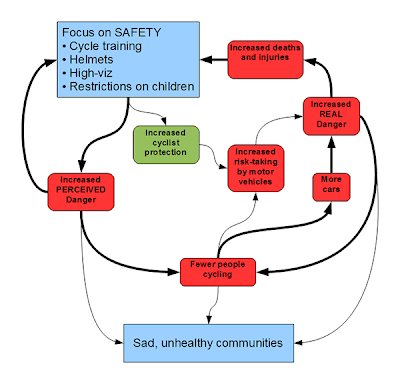I've been thinking about the "war on the motorist" and the terrorising of our residential streets by motor vehicles, coupled with a media interest in cycle "helmets" and the dangers of cycling in the UK. What are we doing? I think there are two different ways of approaching the problem.
Increased Safety for Cyclists
A large amount of effort is being focussed on increasing safety for cyclists, without making any changes to motorists at all. We see strong campaigns for cyclists to always wear "helmets", high-visibility clothing, and to take BikeAbility training courses to learn how to deal with motor traffic. The emphasis is entirely on getting cyclists to make changes.
Here is a cause-and-effect diagram I created to show how this creates an "arms race" between the danger caused by the motor vehicles, and the safety measures required by cyclists:
Here, we get perhaps some benefit from giving cyclists more protection, but we don't actually get very many new people cycling. In fact the safety equipment and training we're encouraging makes it clear to non-cyclists that their fears about the dangers of cycling are completely justified.
The reduction in danger possible by wearing polystyrene hats, or flourescent clothing, is minimal. These won't protect you if a distracted car driver drives into you. The benefits of training are also, I think, overstated. Even experienced cyclists are being killed on our roads, not just novices.
The diagram shows several vicious circles, that keep the cycle going:
- Perceived danger → More calls for safety equipment → Increased perceived danger.
- Real danger → Fewer people cycling →More cars →Increased real danger.
- Calls for safety equipment → Perceived danger → Fewer people cycling →More cars →Increased real danger → Increased deaths and injuries → More calls for safety equipment.
The main benefit of this approach is that it's very cheap. Cyclists actually pay for their own protection, and keeping children indoors doesn't cost anything.
This is an arms race, just like those between warring nations, and like our "war on terror" where every action prompts a bigger reaction. There is no way this can lead to more people cycling as a normal mode of transport. It results in people's freedoms being restricted, and much pain and suffering.
Reduced Road Danger
The opposite way of approaching the problem is to focus on the causes of the danger, rather on the safety of the victims.
Here is a similar cause-and-effect diagram:
Here we have fewer circles, and they're no longer vicious ones. In fact, the whole effect is remarkably more pleasant.
The only problem with this approach is that it's more expensive and time-consuming than getting cyclists to protect themselves. However the Dutch and Danish have shown what can be done with the right political will and a decade or two of time. Cycle facilities are orders of magnitude cheaper than motorways, and 20's Plenty for Us is extremely cost-effective.
This is disarmament: everyone lays down their weapons, the two sides talk to each other, and peace prevails. What's more, there are no vicious circles: once we've removed the danger we can relax and enjoy life!


